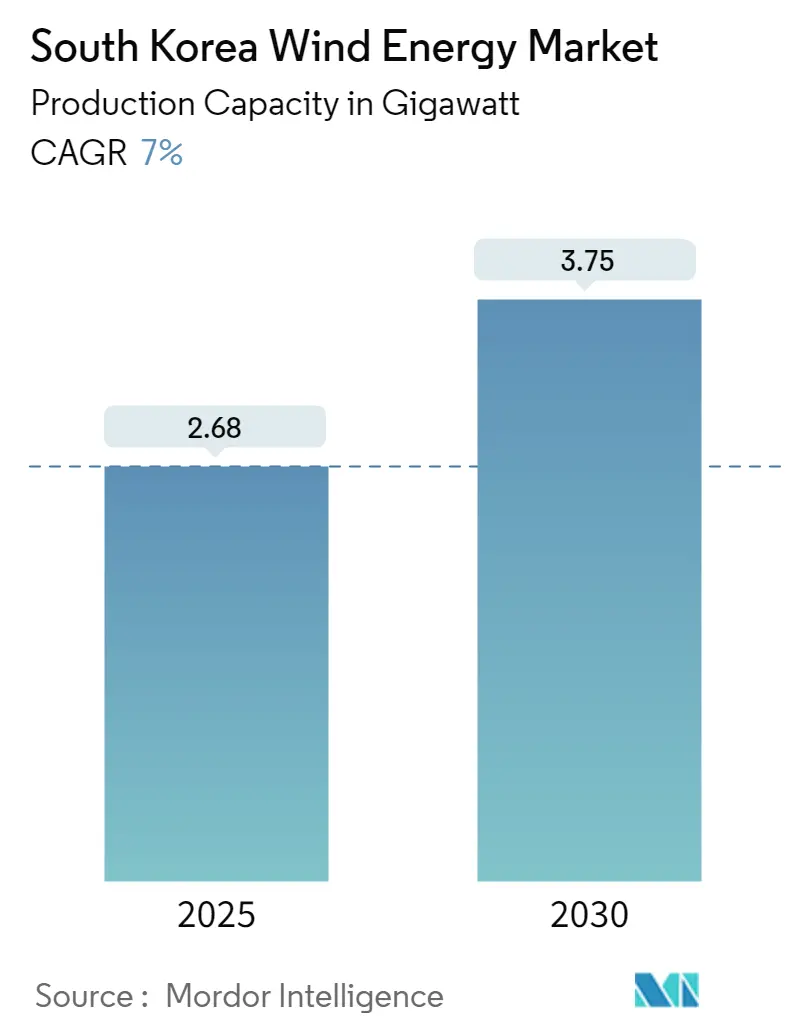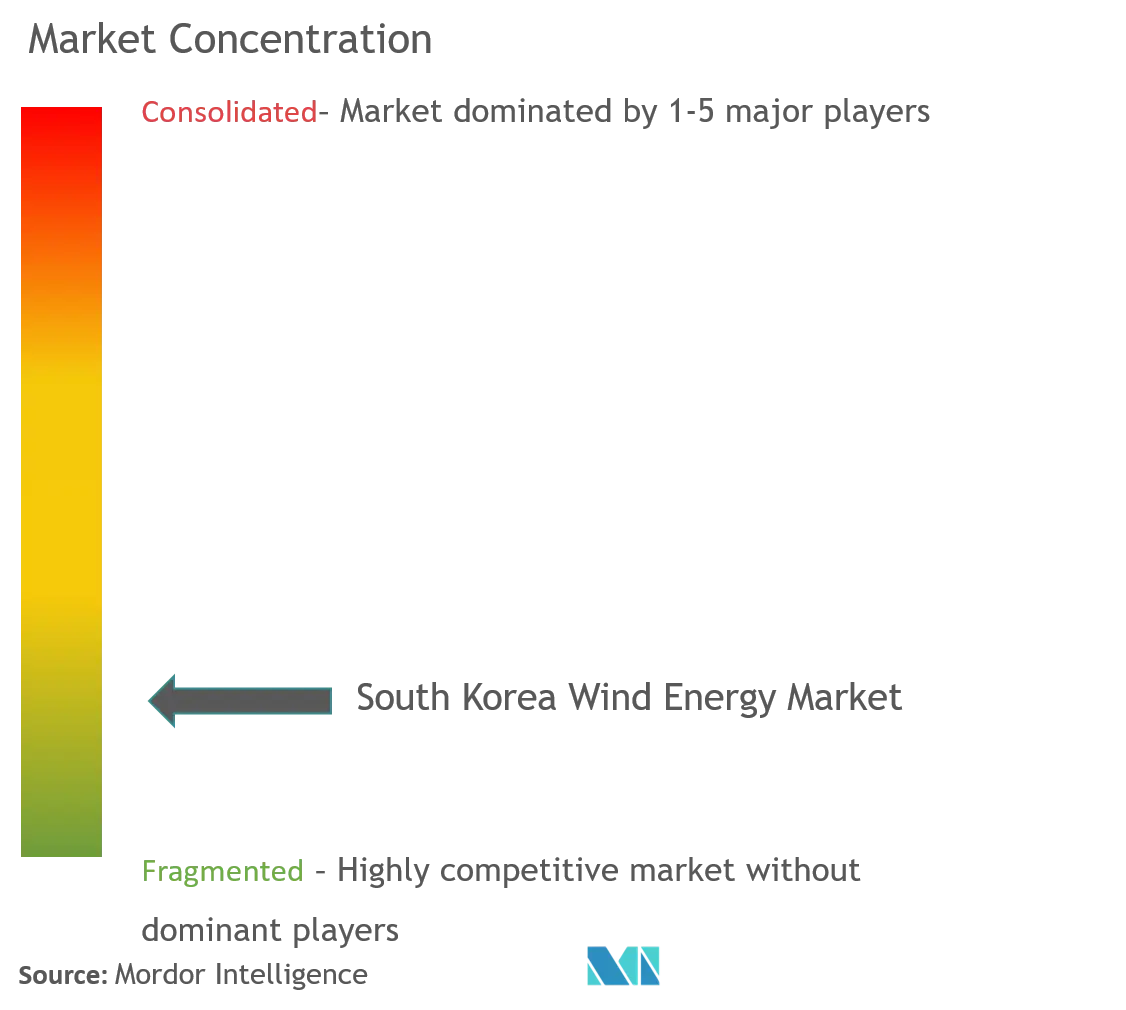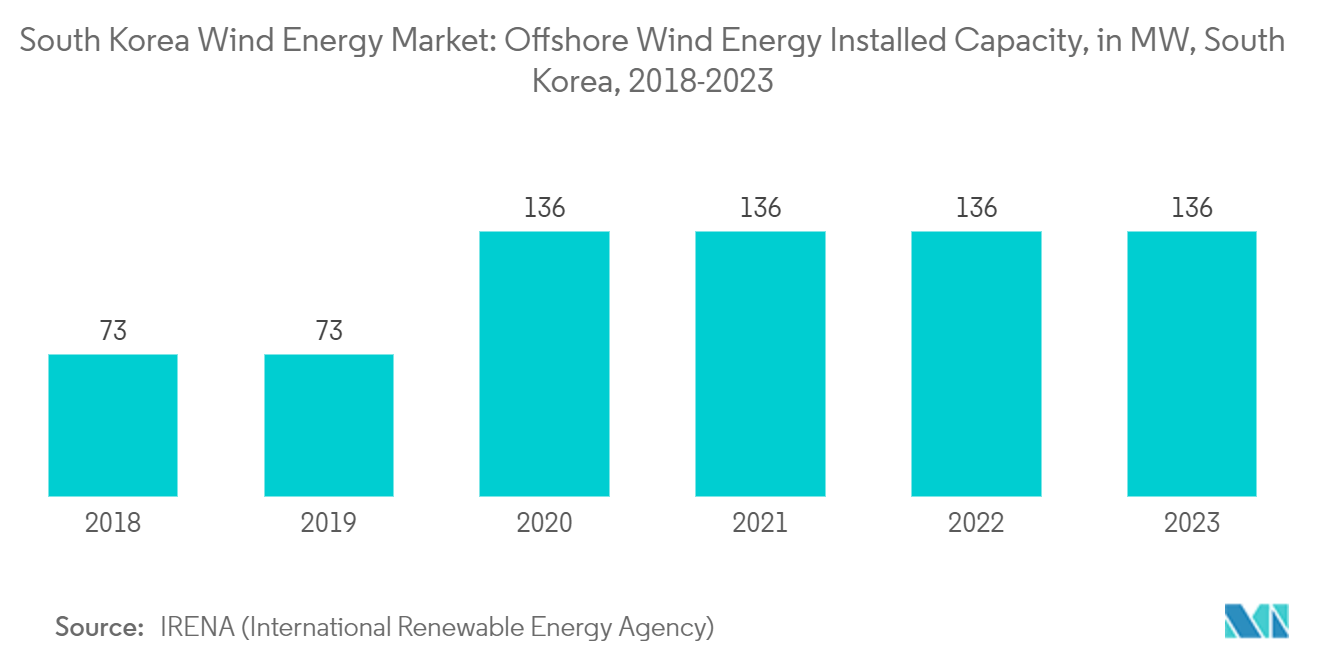
| Study Period | 2019 - 2030 |
| Base Year For Estimation | 2024 |
| Forecast Data Period | 2025 - 2030 |
| Market Volume (2025) | 2.68 gigawatt |
| Market Volume (2030) | 3.75 gigawatt |
| CAGR | 7.00 % |
| Market Concentration | Medium |
Major Players
*Disclaimer: Major Players sorted in no particular order |
South Korea Wind Energy Market Analysis
The South Korea Wind Energy Market size in terms of production capacity is expected to grow from 2.68 gigawatt in 2025 to 3.75 gigawatt by 2030, at a CAGR of 7% during the forecast period (2025-2030).
- In the medium term, the primary driver for the market will be the government's efforts to reduce dependency on fossil fuels and thereby improve the country's air quality.
- A lack of investment due to the low rate of return on invested capital is likely to hinder the market's growth during the forecast period.
- Nevertheless, with the objective of increasing its renewable share in the country's energy mix to 20% by 2030, South Korea is expected to increase its renewable capacity to 63.8 GW by 2030. Moreover, wind energy in the country is expected to increase its capacity to nearly 17.7 GW by 2030, which is likely to create an opportunity for the market to grow in the near future.
South Korea Wind Energy Market Trends
The Onshore Segment is Expected to Dominate the Market
- As one of the largest economies in Asia-Pacific, South Korea has been pushing to reduce its heavy reliance on coal and nuclear power. In response to the rising environmental concerns, South Korea plans to boost the share of renewable power generation to as much as 35% by 2040. Further, the country's pledge to reach net zero by 2050 was a significant pronouncement from an Asian industrial powerhouse.
- According to the country's third Energy Master Plan (EMP) 2019, the government aims to increase the share of renewable power from 6.5% to 20% by 2030 and 30-35% by 2040.
- According to the International Renewable Energy Agency, onshore wind energy was the prominent segment in the South Korean wind energy sector, with nearly 2.03 GW of installed capacity as of 2023. With an increase in demand for cleaner energy, the segment is expected to grow further with the implementation of new onshore wind projects.
- Onshore wind turbines are easier to install and are low in investment compared to offshore. According to the Energy Information Administration (EIA), offshore wind is 2.6 times more expensive than onshore wind power. It is 3.4 times more expensive than power produced by a natural gas combined-cycle plant.
- In June 2024, Vestas got an order for a 90 MW order to power a wind project in South Korea. The order consists of 21 V136-4.2 MW wind turbines in 4.3 MW. The project is expected to be commissioned in 2026. Such types of projects are expected to drive the expansion of the onshore wind market during the forecast period.
- Thus, completing the under-construction and planned projects is likely to increase the overall onshore installed capacity and dominate the country's wind energy market.
Upcoming Offshore Wind Projects are Expected to Drive the Market
- The country has large onshore wind potential, but development has faced problems with complex permitting, local opposition, and growing grid connectivity issues. Thus, while onshore wind capacity is expected to increase, South Korea is turning to offshore wind as the big game changer, announcing some of the most ambitious projects in the world.
- South Korea targets 9.2 GW of wind power by 2025 and 16 GW by 2030, of which 12 GW will comprise offshore wind. This may be an over-reach, considering the 2.03 GW of onshore wind and 136 MW of offshore wind installed as of 2023.
- Further, several companies have been investing in offshore wind energy projects. For instance, in February 2023, BP and Deep Wind Offshore formed a joint venture to explore offshore wind opportunities in South Korea. Under the agreement, BP secured a majority stake of 55% in Deep Wind Offshore's nascent offshore wind portfolio. This portfolio encompasses four projects spanning the Korean peninsula, with a substantial generating potential of 6 GW.
- The government of South Korea aims for 22% of its energy to come from renewable sources by 2030. This target is expected to create a significant opportunity for offshore wind in the country, as it has great potential in the upcoming period.
- Moreover, with rising challenges like limited onshore land for setting up onshore wind farms, the government's concentration toward offshore is growing. It is likely to invest KRW multi-trillion in the R&D of wind technology, which will develop the offshore sector in the upcoming years.
South Korea Wind Energy Industry Overview
The South Korean wind energy market is moderately fragmented. The key players in the market are Equinor ASA, Vestas Wind Systems AS, Siemens Gamesa Renewable Energy SA, Global Wind Energy Co. Ltd, and Hyosung Heavy Industries.
South Korea Wind Energy Market Leaders
-
Equinor ASA
-
Vestas Wind Systems A/S
-
Siemens Gamesa Renewable Energy SA
-
Global Wind Energy Co. Ltd
-
Hyosung Heavy Industries
- *Disclaimer: Major Players sorted in no particular order

South Korea Wind Energy Market News
- April 2024: RWE AG, a German multinational energy company, was granted a 495 MW electricity business license (EBL) by the Ministry of Trade, Industry, and Energy in South Korea for the development of the Seohae offshore wind project, situated off the coast of Taean County.
- February 2024: Aker Solutions, a Norway-based company, was awarded a contract that includes front-end engineering and design (FEED) for the Haewoori Offshore Wind 2 and 3 projects. The project is expected to be located offshore Ulsan, South Korea, each with a capacity of 500 MW.
South Korea Wind Energy Industry Segmentation
The wind is used to produce electricity by converting the kinetic energy of air in motion into electricity. By rotating the rotor blades, wind transforms kinetic energy into rotational energy. The rotational energy is transferred to the generator through a shaft, thereby generating electrical power.
The South Korean wind energy market is segmented by location of deployment. By location of deployment, the market is segmented into onshore and offshore. For each segment, the market sizes and forecasts have been done based on installed capacity (GW).
| Location of Deployment | Onshore |
| Offshore |
South Korea Wind Energy Market Research FAQs
How big is the South Korea Wind Energy Market?
The South Korea Wind Energy Market size is expected to reach 2.68 gigawatt in 2025 and grow at a CAGR of 7% to reach 3.75 gigawatt by 2030.
What is the current South Korea Wind Energy Market size?
In 2025, the South Korea Wind Energy Market size is expected to reach 2.68 gigawatt.
Who are the key players in South Korea Wind Energy Market?
Equinor ASA, Vestas Wind Systems A/S, Siemens Gamesa Renewable Energy SA, Global Wind Energy Co. Ltd and Hyosung Heavy Industries are the major companies operating in the South Korea Wind Energy Market.
What years does this South Korea Wind Energy Market cover, and what was the market size in 2024?
In 2024, the South Korea Wind Energy Market size was estimated at 2.49 gigawatt. The report covers the South Korea Wind Energy Market historical market size for years: 2019, 2020, 2021, 2022, 2023 and 2024. The report also forecasts the South Korea Wind Energy Market size for years: 2025, 2026, 2027, 2028, 2029 and 2030.
Our Best Selling Reports
South Korea Wind Energy Industry Report
Statistics for the 2025 South Korea Wind Energy market share, size and revenue growth rate, created by Mordor Intelligence™ Industry Reports. South Korea Wind Energy analysis includes a market forecast outlook for 2025 to 2030 and historical overview. Get a sample of this industry analysis as a free report PDF download.






